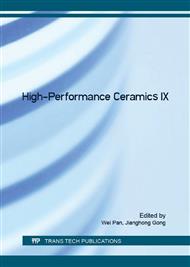p.457
p.462
p.467
p.472
p.476
p.481
p.485
p.489
p.494
Fabrication of Mullite Coating and its Oxidation Protection for Carbon Fiber Reinforced SiC Composites
Abstract:
To protect carbon fiber-reinforced SiC (C/SiC) composites against oxidation,mullite coating was prepared on C/SiC composites by dip-coating method with high solid content Al2O3-SiO2 sol as raw materials. X-ray diffraction and scanning electron microscopy were employed to analyze the phase and microstructure of the coating. The results show that the as-prepared coating is SiO2-rich, monolithic and well bonded with substrate without penetrating crack, giving rise to good oxidation-resistance. After soaked at 1400°C for 30min under static air, the coated C/SiC composites possess 87% of original flexural strength. As a result of sealing and filling of cracks and pores by viscous SiO2 in coating, the coated C/SiC composites exhibit improved oxidation resistance at 1500°C and 1600°C. There is no change in flexural strength after oxidized at 1500°C and 1600°C for 30min, respectively. Nevertheless, the carbothermal reduction between viscous SiO2 and free carbon in C/SiC substrate would occur obviously when oxidation temperature was elevated or oxidation time was prolonged, leading to local foaming in coating and decreasing in oxidation resistance.
Info:
Periodical:
Pages:
476-480
Citation:
Online since:
July 2016
Authors:
Keywords:
Price:
Сopyright:
© 2016 Trans Tech Publications Ltd. All Rights Reserved
Share:
Citation:


